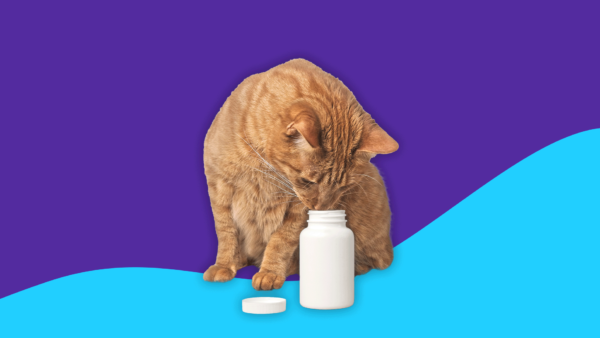Key takeaways
Do not give mirtazapine to dogs if the dog is allergic to mirtazapine or is treated with linezolid, selegiline, or amitraz.
The standard mirtazapine dosage for dogs is 0.6 mg/kg by mouth every 24 hours.
The most common side effects of mirtazapine in dogs are drowsiness, sleepiness, and poor coordination.
Do not give mirtazapine to dogs if the dog is allergic to mirtazapine or is treated with linezolid, selegiline, or amitraz.
Used as an antidepressant in human patients, mirtazapine is usually given to stimulate appetite in cats and dogs, particularly when they’re sick and refuse to eat. However, veterinarians mostly use mirtazapine in cats who aren’t eating because of chronic kidney disease or other sickness. Mirtazapine is well-studied in cats, but its use in dogs is not well-researched. For this reason, its use in dogs is off-label. When used in dogs, veterinarians base many of their decisions on what is known about the drug from its use in cats and people.
RELATED: Save up to 80% on mirtazapine
What is mirtazapine used for in dogs?
Veterinarians use mirtazapine in dogs and cats to treat loss of appetite or nausea.
Mirtazapine works by changing the balance of the chemicals that pass signals between nerves. Researchers are unsure how it helps animals with poor appetites or nausea, but increased appetite and weight gain are common side effects when people take mirtazapine.
Poor appetite (hyporexia or anorexia)
Mirtazapine has not been studied in dogs, but anecdotal evidence suggests it can help dogs refusing food because they’re sick. That’s the usual reason dogs lose their appetite. However, dogs may also stop eating because of stress, separation anxiety, chronic pain, or dental problems. Mirtazapine does not fix the underlying cause. Instead, it makes the dog feel hungry. So, even though the dog still feels bad, it’s more driven to eat.
Nausea and vomiting
Mirtazapine affects several nerve receptors, so it has many effects. One of its effects is to block the circuit that passes signals between the digestive system and the brain’s “nausea center.” In this way, it dulls a dog’s nausea reflex, reducing vomiting and making it more comfortable. Veterinarians may use it in a cat to prevent nausea and vomiting due to chemotherapy. Its use as an antiemetic in dogs hasn’t been studied. However, it may help when a dog isn’t eating but is also nauseous and vomiting.
Is mirtazapine safe for dogs?
Mirtazapine has not been studied in dogs, but veterinarians believe it is safe for dogs based on their experience with cats and the drug’s long history of use in human patients. Keep in mind that no drugs are ever 100% safe, even when they are well-researched.
Some dogs should never be given mirtazapine. At the top of the list are dogs that have had allergic reactions to mirtazapine. Dogs taking a type of drug called an MAO inhibitor (MAOI) should also not take mirtazapine until the MAO inhibitor is discontinued for at least two weeks.
Liver disease is another problem. The dog’s liver breaks down mirtazapine, so the dog is more likely to experience both common and severe side effects. Again, this has not been studied in dogs, so veterinarians do not have specific guidelines for adjusting the dose in dogs with liver impairment.
Side effects of mirtazapine in dogs
Veterinarians are very familiar with the side effects of mirtazapine in cats. For dogs, there is little information about side effects. Given the experience with cats, the potential side effects of mirtazapine in dogs could be:
- Drowsiness
- Sleepiness
- Loss of coordination
- Drooling
- Agitation
- Restlessness
- Shaking
- Low energy
- Low blood pressure
- Fast heart rate
- Increased blood levels of liver enzymes
Anecdotal evidence suggests that dogs are less likely to react adversely to mirtazapine than cats. Veterinarians do know that mirtazapine side effects are dose-dependent; the larger the dose, the more likely and more severe these problems are.
Possible serious side effects include serotonin syndrome, a potentially serious complication that arises when drugs like mirtazapine raise serotonin levels to critical levels. If the dog starts having a combination of unusual symptoms like vomiting, diarrhea, agitation, restlessness, disorientation, fever, shaking, jerking, dilated pupils, vocalization, muscle rigidity, loss of coordination, or seizures, then call a veterinarian or take the dog to an emergency veterinary hospital. These are all possible signs of serotonin syndrome.
Interactions of mirtazapine with other pet meds
As with all prescription drugs, mirtazapine can cause problems when combined with other drugs or substances. For this reason, always tell the veterinarian about all the prescription drugs, over-the-counter medications, nutritional supplements, and herbal remedies the dog is taking. Most are probably safe, but the veterinarian will know for sure.
Among mirtazapine’s drug interactions, the ones veterinarians worry about include:
- Monoamine oxidase inhibitors (MAOIs): If the dog is being treated with the antibiotic linezolid, the senility drug selegiline, and the topical flea medication amitraz. These drugs must be stopped at least 14 days before the dog can safely take mirtazapine and cannot be used when the dog is on mirtazapine. Both linezolid and selegiline are prescription drugs, but amitraz can be purchased over the counter in flea, mange, or tick dips. So, read labels carefully.
- Benzodiazepines: sedatives may worsen the sedative effects of mirtazapine
- Tramadol: a narcotic painkiller tramadol
- Clonidine: an anxiety treatment
- Fluvoxamine: a selective serotonin reuptake inhibitor (SSRI) antidepressant similar to Prozac (fluoxetine), is used to control behavior problems in dogs
Mirtazapine dosage for dogs
In veterinary literature, the standard recommended mirtazapine dose in dogs is 0.6-1.3 mg/kg taken by mouth every 24 hours to a maximum dose of 30 mg daily. However, while there are versions of cat mirtazapine, such as Mirataz, there are no dog versions. Pet parents will use tablets made for humans or mirtazapine custom-made by a compounding pharmacy. Mirtazapine manufactured for humans has fixed dosage strengths of 7.5 mg, 15 mg, 30 mg, and 45 mg. For this reason, mirtazapine doses are often listed as fixed doses based on a dog’s weight:
- For dogs weighing 6-11 pounds: 3.75 mg taken once per day
- For dogs weighing 12–29 pounds: 7.5 mg taken once per day
- For dogs weighing 30–54 pounds: 15 mg taken once per day
- For dogs weighing 55-75 pounds: 22 mg taken once per day
- For dogs weighing more than 75 pounds: 15 mg taken every 12 hours or 30 mg taken once per day
Can dogs overdose on mirtazapine?
Dogs should not be given more than 30 mg of mirtazapine a day. Mirtazapine overdoses are not well studied in dogs. When humans overdose on mirtazapine, the extra medicine worsens adverse effects like sleepiness, disorientation, fast heartbeats, and memory problems. Excessive mirtazapine overdoses can be fatal in people. If a dog is given too much mirtazapine, call an animal poison control center, talk to the veterinarian, or take the dog to a veterinary hospital.
Can I give my dog mirtazapine every day?
Dogs can take mirtazapine daily if pet parents follow the veterinarian’s instructions. There is no maximum treatment duration. In humans, mirtazapine is used daily over long periods—months or years—without causing side effects or complications due to long-term use.
How to give your dog mirtazapine
When a veterinarian prescribes mirtazapine, pet parents must give the dog tablets. However, a veterinarian may supply mirtazapine in a liquid format made by a compounding pharmacy.
Doses are relatively simple to give. Most dog owners need only give one dose daily:
- Follow all the veterinarian’s instructions.
- Do not change the dose or dosing schedule.
- Give the dog one dose a day unless the veterinarian prescribes two doses a day.
- Mirtazapine can be given with or without food.
- If giving tablets, do not crush them. You will need to place the tablet far back in the dog’s mouth beyond the hump of the tongue. If you don’t know how to do this, ask the veterinarian or other veterinary professional for a demonstration or a pill pusher.
- If a dose is missed, give it on the same day it’s scheduled. If it’s the next day, give the next day’s dose as scheduled while skipping the missed dose. Do not give a double dose to make up for a missed dose.
- Only stop giving the dog doses if instructed to by the veterinarian. Doses may need to decrease to prevent withdrawal symptoms gradually.
Mirtazapine alternatives for dogs
Mirtazapine is not as commonly used in dogs as it is in cats. Veterinarians typically rely on other appetite stimulants because they know more about effective dosages. These include:
- Capromorelin: Capromorelin is the only FDA-approved appetite stimulant for use in dogs. It’s sold as a liquid solution for easy dosing. Veterinarians may prescribe Entyce as its brand-name version.
- Cyproheptadine: Cyproheptadine is another appetite stimulant more commonly used in cats. Veterinarians use it as an antihistamine in dogs, but they may also use it as an appetite stimulant. It may be an option if mirtazapine doesn’t work.
- Steroids: Steroids like prednisone are more commonly used to promote weight gain in animals that are underfed or have poor appetite. All steroids make dogs hungrier, but they can have pronounced side effects.
Summary
Mirtazapine is an effective and relatively safe appetite stimulant, but veterinarians primarily give it to cats. It is not well-researched in dogs, but veterinarians believe it works. It’s an appropriate treatment when dogs regularly refuse food for any reason
Sources
- Amitraz, VCA Animal Hospitals
- Anipryl selegiline hydrochloride tablet prescription animal drug information, NIH National Library of Medicine
- Drugs that affect appetite in monogastric animals, Merck Veterinary Manual
- Drugs used to stimulate appetite, Merck Veterinary Manual
- Mirtazapine, Plumb’s Drugs in Brief
- Mirtazapine, Plumb’s Therapeutic Briefs
- Mirtazapine (Remeron), Veterinary Partner
- Mirtazapine tablet prescribing information, NIH National Library of Medicine
- Plumb’s Veterinary Drug Manual, 7th ed.
- Serotonin syndrome in dogs and cats, Veterinary Partne











